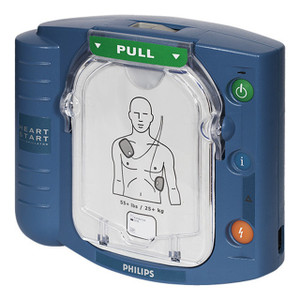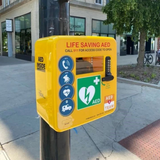Defibrillators in public places
A public access defibrillator (PAD) can be found in local towns and villages and you will often see them installed in a cabinet, usually attached to a wall where lots of people would be likely to walk past. They are there to be used when someone suffers a sudden cardiac arrest (SCA) and can save a life in an emergency.
When next out and about near your home, work or city centre, keep an eye out for where your nearest PAD’s are installed so that should you ever need to use one, you know exactly where one is installed so that you can deliver emergency care as quickly as possible.
PAD’s work the same as any other defibrillator in that they shock a person’s heart who has suffered a cardiac arrest in order for it to start beating at it’s own natural rhythm again. The only difference is, instead of being installed in offices, sports facilities and factories where they can only be used if someone falls ill in those areas, is that a PAD can be used by any member of the public when an emergency occurs.
It may be that someone suddenly falls ill when walking in their local town, or they may have a sudden cardiac arrest at home, if this happens your PAD can be used. To keep them safe from the elements and vandalism, most public access defibrillators are installed in easily identifiable cabinets which are often bright in colour such as yellow so that you can quickly find it.
A PAD cabinet may also have a lock or keypad on it so that the defibrillator inside does not get taken when not needed as they can be expensive. To open the cabinet it is often a simple case of you calling 999 and quoting the number that is on the cabinet - the emergency services will then give you a code to open the cabinet so that you have access to the defibrillator.
With around 80% of out of hospital cardiac arrests occurring at home and 20% in public places, it is important now more than ever to raise the awareness of how important having PAD’s installed across the country is as well as ensuring you are aware of where your nearest one is.
As defibrillators are costly, you can apply for funding and grants as well as local fundraising in order to raise enough money to purchase a PAD. Initiatives such as the National Lottery and Aviva can provide funds in order for you to make the first step towards getting a PAD. With lots of defibrillators on the market, it is important to do your research to help you decide which defibrillator is best for you.
Recent Posts
-
What is CPR?
Knowing the basics of first aid and how to deliver CPR (cardiopulmonary resuscitation) can make the …17th Nov 2024 -
What is a sudden cardiac arrest (SCA)?
Sudden Cardiac Arrest (SCA) is a critical medical emergency where the heart abruptly ceases to funct …17th Nov 2024 -
Empowering Communities: The Lifesaving Impact of CPR on Restart a Heart Day
Every year, on and around October 16th, an important event takes place - Restart a Heart Day. This a …16th Oct 2023




